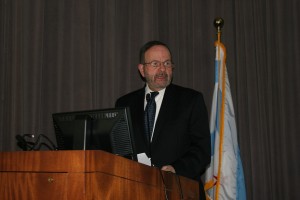
Joseph D. Ament of Much Shelist addresses the symposium. Ament sits on John Marshall’s Braun Bequest Fund Annual Lecture Series Committee.
As depicted in films like “Woman in Gold” and “Monuments Men,” reclaiming art stolen during times of war can be a difficult, lengthy and legally murky process. Experts at The John Marshall Law School discussed how attempting to reclaim such treasure can mean a legal attempt to reclaim cultural heritage and human rights.
This year’s Braun Symposium Oct. 15-16, at John Marshall in Chicago, addressed efforts to return art stolen during war, and the complicated legal questions of ownership and ethics that often arise. The symposium also considered the destruction of cultural heritage, both as deliberate acts of war and as unfortunate side effects of military action. Experts from academia, law practice and government debated how best to protect art and cultural heritage.
Among the experts who spoke were Donald Burris, managing partner at Burris, Schoenberg & Walden, LLP, in Los Angeles. The legal casework done by Burris and his partner, E. Randol Schoenberg, is the basis for the movie “Woman in Gold.” The symposium was presented by The John Marshall Review of Intellectual Property Law, the International Human Rights Clinic and the L.A. Museum of the Holocaust. The program addressed several concepts:
- Where Are We and Where Are We Going: Legal Developments in Cultural Property and Nazi Art Looting
- Repatriation as a Human Right
- Cultural Plunder and Restitution and Human Identity
- International Human Rights and the Protection of Cultural Property During Armed Conflict: Siblings Separated at Birth
- WWII in 2016: A Copyright Shift
- When Objects Go Back (Or Not) – Issues in Cultural Property Restitution and Return
- Restoration of Looted Art: Altmann, Benningson and Their Progeny
